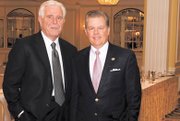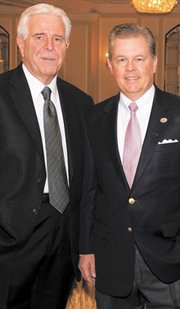AAFA Summit Takes Apparel Makers Inside the Beltway
WASHINGTON, D.C.—For the second consecutive year, the American Apparel and Footwear Association hosted an inside-the-Beltway Executive Summit that highlighted the key issues affecting apparel makers against the backdrop of domestic policy and global politics.
By hosting the Executive Summit in its home base of Washington, D.C., the AAFA is able to highlight its clout with lawmakers.
“We are an enormous industry,” said Kevin M. Burke, president and chief executive officer of the AAFA, adding, “We have a great story to tell.”
To illustrate the scale of the apparel and footwear industry, he compared the industry’s annual revenues of $370 billion to the bottled-water business ($17 billion), fast food ($170 billion), the auto industry ($174 billion) and the alcohol industry ($272 billion).
Despite its size, the apparel and footwear industry is facing several challenges this year, including rising raw-material prices, stalled trade agreements and strict regulations.
“This administration talks a good deal about free trade but hasn’t done anything,” Burke said. “We need a 21st-century trade policy.”
Trade issues are key for many of the attendees at the March 2–4 event, held at the historic Willard InterContinental Hotel. AAFA members include many of the country’s largest manufacturers, many of whom produce mostly offshore. The summit drew representatives from The Jones Group, Ann Taylor, Jockey, Byer California, Haggar Clothing, Kellwood Co., VF Corp. and Donna Karan International, as well as representatives from technology companies including SAP, Gerber Technology and Siemens.
In recent years, the AAFA has been stepping up its education outreach—both in the United States and overseas in production centers such as China, Vietnam, Bangladesh and India. The organization is looking to educate its members on environmental issues, regulatory compliance and strategies for improving supply-chain efficiency.
Arguably, the biggest challenge of 2011 will be cotton prices, which have risen from about 70 cents per pound in 2007 to $1.05 per pound in 2010 and are on track to exceed $2 per pound this year, said J. Berrye Worsham, president and chief executive officer of Cotton Inc.
“We’ve never seen anything like this,” he said. “The closest was in ’73, when oil prices soared.” Although the United States is still the largest consumer of cotton, other growing markets around the world are increasing their demand for cotton, pushing prices up further. “Consumers are used to no increase in the price of clothing, so [an average estimated] 6 percent increase will be massive,” Worsham said. “Margins will be under pressure.” Where in the world
For many in the industry, the answer to rising raw-materials costs is a lean and efficient supply chain—and finding the right place to produce.
For Hong Kong–based manufacturer Luen Thai, that place is Dongguan, China, where the 28-year-old company has set up a “Supply Chain City,” where the company can provide services from design development through manufacturing and logistics under one roof.
Still, the mega-facility model is not without its challenges, according to Henry Tan, the company’s chief executive officer and president, who discussed a few, including rising labor costs and the pressure to move manufacturing into the country’s interior.
“A lot of the development we are seeing is not happening in Western China,” he said.
A summit attendee asked Tan where he would go if he could move production today. “Indonesia,” he said. “Or Cambodia. But I think companies would take longer before they would go to Indonesia, so I’d have a lot more time there.”
(After fielding a few more questions, one attendee said, “I wish you would have kept Indonesia a secret and not broadcast that to the world,” to which Tan replied, “Maybe I should retract my statement about Indonesia and say the Philippines instead.”)Changing of the guard
The AAFA also installed a new chair at the Executive Summit, Rick Darling, president of LF USA, the New York–based subsidiary of Hong Kong–based apparel and footwear manufacturing giant Li & Fung Ltd.
Darling took over for outgoing chair Killick Datta, chairman and chief executive officer of Santa Barbara, Calif.–based footwear maker International Brand Partners LLC.
Philip Williamson, chairman, president, and CEO of Williamson-Dickie Manufacturing, was named vice chairman; Joseph Gromek, president and CEO of Warnaco Inc., was named treasurer; and Rick Helfenbein, president of TellaS Ltd. and Luen Thai USA, was named secretary.
Social media and the impact on marketing
The AAFA Executive Summit kicked off with a look at social media and how one retailer is using new tools—including Facebook—to engage its customers.
Jon Kubo, vice president and chief information officer of Foothill Ranch, Calif.–based The Wet Seal Inc., discussed his company’s “social merchandising strategy,” which has been at the root of the juniors retail chain’s social-media efforts since 2008, when the company added a user-generated content component to its website (www.wetseal.com).
“[Social merchandising] has nothing to do with the traditional merchandising function,” Kubo said. “It’s about users putting together looks and distributing to their friends to get recommendations on what to wear.”
Since its launch, Wet Seal customers have posted 1 million outfits on the company’s website. In 2009, the company launched its “virtual runway” application on the product pages—in effect allowing customers to see how other shoppers put together their looks—and the company saw its e-commerce revenue increase by 20 percent, Kubo said, adding that the application has led to a 40 percent increase in conversion and a 20 percent increase in average orders.
“Typically, we have about 5 percent of the ’passionate’ people willing to create user-generated content,” Kubo said. “The most important thing is to connect the 5 percent to the other 95 percent.”
The virtual runway has since rolled out to Wet Seal’s Facebook page, and there’s a mobile-phone version, as well.
“The key to Facebook is creating campaigns,” Kubo said. The Wet Seal typically creates six campaigns per year. A recent Wet Seal model-search campaign on Facebook generated 35,000 entries and 100,000 store visits. And every time a customer clicks on the Facebook “like” button, Wet Seal gathers more market intelligence, Kubo said. “We put the Facebook ’like’ information into the warehouse database,” he said.
Next up, the retailer plans to launch a Wet Seal Facebook game this summer. The game will allow Wet Seal fans to run their own virtual Wet Seal store.
Mike Haines, regional vice president of Facebook, highlighted his company’s reach—600 million active users—and how time spent online has changed over the last 20 years.
“The ’90s were all about browsing,” he said. “The 2000s were about search. The current generation is all about discovery of information through their real friends. We’ve moved from the wisdom of crowds and machines to the wisdom of people and friends.”
Haines said Facebook’s friend-based model will allow companies to leverage that wisdom of friends to help target potential customers. According to Haines, there are three types of marketing: paid (meaning traditional advertising), owned (meaning existing customers) and earned (meaning market share gained through public relations).
“Facebook allows you to create earned marketing at an unprecedented scale,” he said. Political party
For the political junkies in attendance, there was plenty of inside-Washington fare on the agenda at the summit, including sobering presentations about international security by Stephen Hadley, former national security adviser to President George W. Bush, and General Michael Hayden, former director of the Central Intelligence Agency and former director of the National Security Agency.
Hayden discussed political “hot spots” around the world, including Iran, China, the Middle East and Mexico. Hadley agreed, adding, “This is one of the most challenging environments since the darkest days of the Cold War. It’s like a 12-burner stove, and on every burner is a pot and every one is threatening to boil over.”
Hadley pointed to China as a new frontier for the apparel and footwear industries.
“What your industry knows is that China represents an enormous economic opportunity for American business,” he said. “The U.S. needs to be active in Asia in every dimension of power and influence. We’ve got to get into the free-trade game in Asia. If we do not—if you forgive the pun—the Asian market will be sewn up.”
Also on the political slate was a presentation by David Eisenhower, historian, professor and public-policy fellow—and grandson of President Dwight D. Eisenhower—about his travels over the years in China; a surprisingly funny repartee between political pundits Patrick Buchanan and Mark Sheilds; and a Newt Gingrich book signing.
























